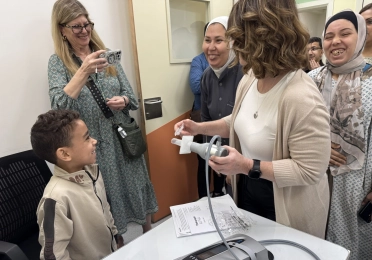Precisely Speaking: Strengths and Weaknesses of Spirometry
Part 4 of our Precisely Speaking blog series that explores how precision medicine can be applied to enhance diagnostic accuracy, particularly using spirometry and other testing methods.
Spirometry is a crucial tool in diagnosing and monitoring respiratory conditions like asthma, chronic obstructive pulmonary disease (COPD), and other pulmonary disorders. It provides valuable insights into lung function by measuring the volume and flow of air that a person can inhale and exhale. While spirometry is highly effective in clinical practice, it is not without its challenges. Clinicians often face barriers that can make spirometry testing less accessible or accurate, such as patient compliance, equipment limitations, and the need for proper training.
This blog will explore three of the key obstacles that clinicians must overcome to implement it effectively. Understanding these factors is essential for improving the reliability and accessibility of spirometry testing in everyday practice.
What is Spirometry?
Spirometry is a common pulmonary function test that measures lung function by assessing the volume and flow of air in and out of the lungs. It is a widely used diagnostic and monitoring tool for respiratory diseases, including chronic obstructive pulmonary disease (COPD), asthma, and cystic fibrosis. By providing detailed insights into lung function, spirometry helps clinicians diagnose and monitor these conditions effectively. This is particularly important as spirometry can reveal respiratory issues that might not be apparent through physical examination alone. Understanding lung function through spirometry is crucial for managing chronic obstructive pulmonary disease and other lung diseases.
All of Vitalograph’s respiratory diagnostic solutions enable professionals to diagnose respiratory health in the most efficient and effective way, for optimum patient centric care.
The Spirometry Test Process
Preparing for the Test
Before undergoing a spirometry test, patients may be asked to:
Stop smoking.
Avoid strenuous exercise.
Avoid certain medications that can affect lung function, such as bronchodilators.
Refrain from eating a heavy meal before the test.
Avoid caffeine and other stimulants.
These precautions help ensure that the spirometry results are accurate and reliable, providing a true reflection of the patient’s lung function.
Performing the Test
The spirometry test is typically conducted at a medical office or in a specialised lung-function laboratory. Soft clips are placed on the patient’s nose to ensure they breathe in and out only through the mouthpiece attached to the spirometer.
The patient takes a deep breath in
Then the patient blows forcefully into the spirometer through the mouthpiece.
The spirometer measures the amount of air the patient exhales and inhales. To ensure accurate and reproducible results, the patient repeats the test at least three times. This process helps clinicians obtain a clear picture of the patient’s lung function.
Understanding Spirometry Results
Spirometry results are essential for diagnosing and monitoring respiratory diseases, including COPD and asthma. The test measures several key parameters:
FEV1 - Forced Expiratory Volume - this measures the amount of air a person can forcefully exhale in one second.
FVC - Forced Vital Capacity which measures the total amount of air exhaled during the test.
PEF - Peak Expiratory Flow indicates the fastest rate at which air is expelled from the lungs.
These parameters are critical for assessing lung function and diagnosing conditions like chronic obstructive pulmonary disease and other obstructive lung diseases. Understanding these values helps clinicians make informed decisions about patient care.
Training and Education on Spirometry, FeNO, and Oscillometry
Proper training is essential for healthcare providers to accurately perform and interpret spirometry tests. The American Thoracic Society (ATS) and the European Respiratory Society (ERS) have established comprehensive guidelines for spirometry training, which cover proper technique, quality control, and result interpretation.
In addition to spirometry:
FeNO (fractional exhaled nitric oxide) measures nitric oxide in exhaled breath, aiding asthma diagnosis
Oscillometry assesses lung function by measuring the resistance and reactance of the lungs
Training and education on these tools are crucial for healthcare providers to accurately diagnose and manage respiratory diseases, ensuring optimal patient outcomes.
Barriers to Testing
1. Training and education on spirometry, FeNO and oscillometry
There is considerable merit in training and educating healthcare professionals on the utility of spirometry, FeNO, airway oscillometry, and other pulmonary function testing techniques in the management of asthma. This might involve in-person workshops where the individual pulmonary function test techniques are demonstrated as well as larger scale webinars where knowledge and theory are disseminated.
Whilst most healthcare professionals are aware and familiar with the concept of spirometry, the use of this modality might be rendered difficult by the absence of adequate training and education. In this regard, the Association for Respiratory Technology and Physiology (ARTP) provide a detailed list of external institutes and independent trainers who provide spirometry training. Comprehensive theory behind spirometry can also be accessed in the document termed “Standardization of Spirometry 2019 Update” published in the American Journal of Respiratory and Critical Care Medicine.
On the other hand, FeNO and airway oscillometry are typically secondary care investigations so perhaps fewer clinicians are familiar with performing and interpreting values. Standardised procedures for FeNO testing were published in 2005 by ATS/ERS and subsequently clinical practice guidelines for the use of FeNO were made available from ATS in 2011. The e-learning for healthcare program provide digital FeNO education that is endorsed by the ARTP and asthma UK. Device manufacturers also provide specific procedural advice for their respective devices.
In terms of airway oscillometry, the European Respiratory Society published “Technical standards for respiratory oscillometry” providing solid recommendations on hardware, software, testing protocols and quality control. Although there is plenty of data supporting the use of oscillometry in asthma, there remains a paucity of in-person workshops to bring oscillometry into the mainstream for clinicians, and this might be something we should consider moving forward. Furthermore, the current Global Initiative for Asthma (GINA) recommendations do not include the utilisation of airway oscillometry. Similar to FeNO where there are multiple device options, airway oscillometry is also complicated by the issue of potential bias between devices.
Another potential solution is to create oscillometry “centres” where designated hospitals are responsible for hosting healthcare professionals from elsewhere to obtain pragmatic experience in a real-life clinical or research setting. After all, although theory is mandatory, it is seldom a substitute for valuable clinical experience accumulated from utilising these devices and techniques in practice. With all investigations, it is important to standardise procedures so that accurate treatment decisions can be made and test values can be reliably compared between centres.
2. Interpretation and acceptance of test data value
Test data from spirometry, FeNO, and airway oscillometry should always be interpreted in light of other circumstances since lung function tests are invariably complicated. For example, many modifiable factors can affect FeNO values such as inhaled corticosteroids, smoking, physical exercise, repeated spirometry, and bronchoconstriction. Moreover, oscillometry should always be performed prior to tests requiring deep breaths such as spirometry and FeNO. Indeed, there is even intraindividual variation in FeNO and oscillometry between devices so it is advised that the same device is used longitudinally both in the clinical and research setting to maintain reliability of readings.
Whilst spirometry values have traditionally been presented as percentage predicted or as z-scores, options for oscillometry include interpreting data as absolute values (in kPa/L or cmH20) or as percentage predicted numbers. Data has also recently been published to support the use of oscillometry ratios as peripheral divided by total airway resistance (R5-R20/R5 x 100) as well as low frequency reactance divided by total reactance area (X5/AX x 100). In this regard, ratios might be a way of overcoming potential bias from different devices.
3. Accessing the equipment – proving benefit to patients
We already know that combined impairment of spirometry with FeNO, or oscillometry with spirometry, is associated with increased odds of poor asthma control and a greater severe exacerbation frequency, highlighting the importance of comprehensive lung health assessment. In turn, more exacerbations are closely related to further lung function decline linked to mortality. The next step would naturally be to perform a longitudinal study comparing the management of asthma based on using traditional spirometry alone versus oscillometry alone and versus a combined approach to respiratory function testing.
It can therefore be quite frustrating for healthcare professionals to be aware of all the benefits of using a combination of modalities to improve patient outcomes but being unable to do so due to lack of resources. For example, many primary care centres (general practice) do not have availability of spirometry or adequately trained staff who can operate the equipment. Another potential barrier is the cost of devices, mouthpieces and filters, alongside ongoing device maintenance although it is perhaps the responsibility of healthcare professionals to put forward business cases for the attainment of such resources. Although “cost-saving” initially, not using these respiratory diagnostic solutions is short sighted as it can lead to worse patient outcomes and greater healthcare associated costs later. Notably, there is data supporting the use of FeNO in the inpatient setting to differentiate infective versus eosinophilic asthma exacerbations to direct antibiotic or corticosteroid therapy. This leads us nicely back to the introductory concept of precision medicine for superior patient outcomes.
About our Vital Insights guest
Dr Rory Chan (MBChB PhD) is a Consultant Respiratory Physician and Senior Clinical Lecturer at NHS Tayside and University of Dundee. His specialist area of research relates to precision medicine in severe asthma, and he has published articles in top respiratory and allergy journals including AJRCCM, ERJ, JACI and Allergy. He is also an Editorial Board Member at the journal CHEST







